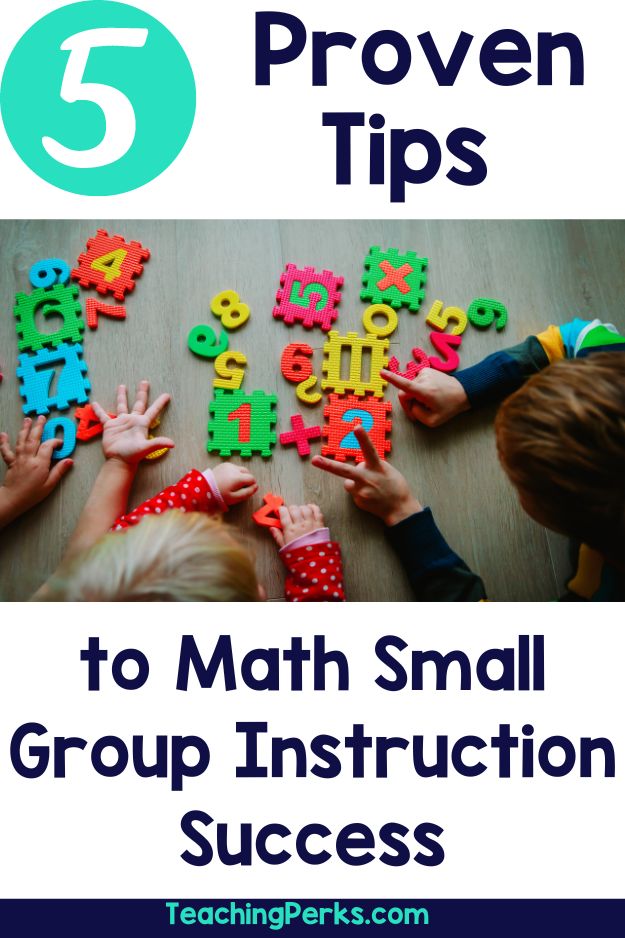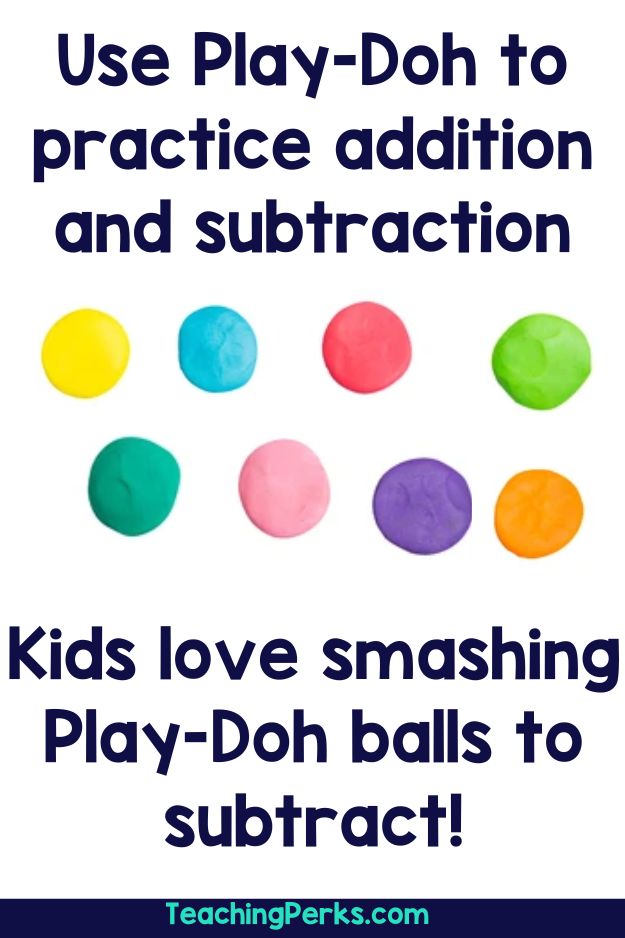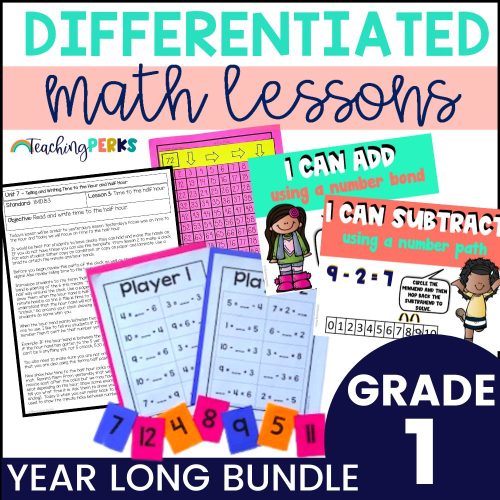As a 1st grade teacher, you know that teaching small group math can be a powerful way to engage your students and help them build a strong foundation in math. However, it can also be challenging to know where to start and how to make the most of small group instruction. To help you out, I’ve put together these five essential tips for teaching math in small groups in 1st grade.


Keep It Hands-On
1st graders learn best through hands-on activities, so be sure to include plenty of manipulatives and other concrete materials in your 1st grade small group math lessons. Manipulatives are any object that students can touch and manipulate to help them understand math concepts.
Examples of manipulatives for 1st grade math include counting bears, base ten blocks, pattern blocks, and number lines.
If you don’t have these things available you can always use real-life objects like coins, buttons, or even snack foods to help students understand concepts like counting, addition, and subtraction.
First graders love Play-Doh! You can use Play-Doh to create fun and interactive math activities. For example, you can use Play-Doh to make numbers and then have students use Play-Doh to make the corresponding amount of objects, such as apples for the number 4.

Or, you can use Play-Doh to make simple addition and subtraction problems and have students manipulate the Play-Doh to solve the problem.
To keep your small group math instruction varied and to cater to different students’ level, make sure to use lesson plans that include a variety of hands-on and differentiated activities for basic addition and subtraction. This will ensure that you provide the right level of support and challenge for each student.
Make It Interactive
1st grade small group math instruction is an opportunity for students to actively participate in their learning, so make sure to include interactive activities that allow them to explore math concepts in a fun and engaging way.
Games, puzzles, and interactive whiteboard activities are all great ways to make math interactive.
For example, you could create a scavenger hunt in the classroom where students have to find and solve math problems, or play a game of math bingo where students have to solve math problems instead of marking numbers on their bingo cards.
Another interactive activity that could be done during small group math is Word Problem Scenarios. In this activity, you can give each small group a word problem scenario, written on a card or a piece of paper, in which they have to act out the situation and find a solution.
For example, you can give them a word problem about buying groceries, and ask them to act out the scenario, pretending to be the customers or the cashier, and find the solution. This activity will not only make math interactive but also make the students practice solving word problems in a fun and engaging way.

To add variety and more practice, you can use differentiated word problem games which are designed specifically for small group instruction and includes a variety of engaging word problem scenarios.
Focus On Key Concepts in 1st Grade Small Group Math
In 1st grade, students are learning basic math concepts like counting, number recognition, and basic addition and subtraction.
Be sure to focus on these key concepts during 1st grade small group math instruction all year long so that students can build a solid foundation in math. Often times we move on to more advanced skills and forget to review the ones that seem so basic.
The best way to make sure students keep a firm grasp on these skills is to incorporate these basic concepts into math warm ups or your math closure. I love to find different counting songs on YouTube that have students count to 120, skip count, count backwards, etc. Jack Hartman has some great videos for this!
If you need some quick and easy ways to practice basic 1st grade math concepts during your small group math time, grab this free download that includes 66 low prep ideas for multiple 1st grade skills!

Differentiate Instruction in 1st Grade Small Group Math
Small group math time provides an opportunity to tailor instruction to the specific needs of each student. Be sure to differentiate instruction by providing different levels of support and challenge for different students.
This can include things like providing extra help for struggling students, or providing more advanced activities for students who are ready for more of a challenge.
To challenge students try this budgeting activity:
Students can work in small group math to plan a pretend class trip. They will have a certain amount of money and they will have to decide how much to spend on different items such as transportation, food, souvenirs, etc. They will use addition and subtraction to create a budget and make sure they don’t spend more than they have. They can also use a visual representation such as a bar graph or a chart to show how much they have spent and how much they have left. As a final step, students can present their budget and the decision they made to the class and explain their reasoning.
This project allows students to apply their understanding of addition and subtraction in a real-life context, to think critically and make decisions based on budget constraints, and to present their work to their peers.

As for struggling students you can take a step back and slow down the process for them. For example, when working with missing addends if students are having a hard time use a think aloud strategy and a number bond or number path. The teacher will model how to find the missing part as she explains her thinking out loud. Sometimes students need to see the teacher model several times and then do some with the teacher before moving to independent work.
Or you can try connecting the missing addend problems to real-life situations. An example of this would be to assign students different pretend classroom jobs and have them practice solving missing addend problems to find out how many more jobs they need to complete.
For example, if a student is responsible for erasing the whiteboard and they have already erased 5 out of 10 problems, they have to solve the problem of 10 – 5 = __ to find out how many more problems they need to erase. Students will need to use some type of manipulative to help them solve. Or they could actually have 10 problems on the whiteboard and erase 5 to see how many are left to see this visually.
With any level of learners always encourage students to work in small groups and discuss the problem-solving process. This will help them to understand how to approach missing addend problems and how to explain their thinking to others.
Make It Fun
Finally, remember that students learn best when they are having fun! Be sure to include plenty of fun and engaging activities in your 1st grade small group math instruction to keep students motivated and excited about learning.
Use games, partner work, fun challenges for advanced students, puzzles, etc!
For example, you could turn any math concept into a game of bingo with math problems instead of numbers, or create a math-themed scavenger hunt where students have to find and solve math problems to win a prize, play mystery number games, have math races and battles. The opportunities for students to have fun in math is endless!

Mastering 1st Grade Small Group Math Conclusion
By following these five essential tips, you can make sure that your small group math instruction is engaging, effective, and fun for your 1st graders. Remember to keep it hands-on, interactive, focused on key concepts, differentiated, and fun to ensure that your students are building a strong foundation in math and having a good time while doing it.
Want me to take all of the planning off of your hands and give you a year’s worth of small group math lessons that do all 5 of these tips plus lots more?
Check out this already made 1st grade math curriculum that will give you everything you need to teach differentiated math small groups all year long!

[…] can be a challenge, especially when it comes to math. Here are 9 tips to help 1st grade teachers make the most of their small group math instruction […]